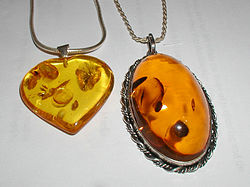This article has multiple issues. Please help improve it or discuss these issues on the talk page . (Learn how and when to remove these messages)
|
| Amber | |
|---|---|
| | |
| Hex triplet | #FFC000 |
| sRGB B (r, g, b) | (255, 192, 0) |
| HSV (h, s, v) | (45°, 100%, 100%) |
| CIELChuv (L, C, h) | (81, 99, 58°) |
| Source | RGB and CMYK color systems. |
| ISCC–NBS descriptor | Vivid yellow |
| B: Normalized to [0–255] (byte) H: Normalized to [0–100] (hundred) | |
yellow |
amber |
orange |

The color amber is a pure chroma color, located on the color wheel midway between the colors of yellow and orange. The color name is derived from the material also known as amber, which is commonly found in a range of yellow-orange-brown-red colors; likewise, as a color, amber can refer to a range of yellow-orange colors. In English, the first recorded use of the term as a color name, rather than a reference to the specific substance, was in 1500. [1]









